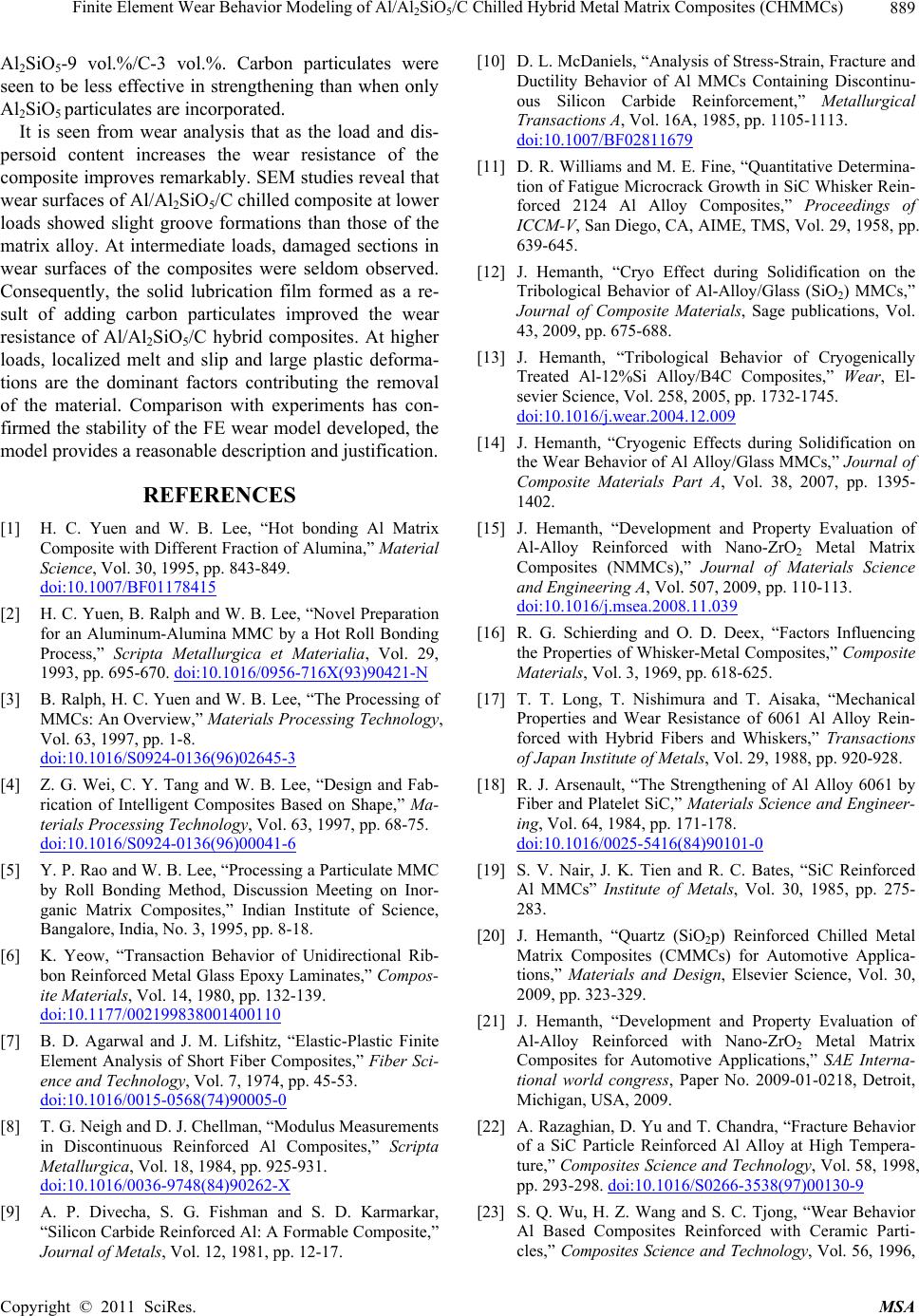
Finite Element Wear Behavior Modeling of Al/AlSiO /C Chilled Hybrid Metal Matrix Composites (CHMMCs)889
2 5
Al2SiO5-9 vol.%/C-3 vol.%. Carbon particulates were
seen to be less effective in strengthening than when only
Al2SiO5 particulates are incorporated.
It is seen from wear analysis that as the load and dis-
persoid content increases the wear resistance of the
composite improves remarkably. SEM studies reveal that
wear surfaces of Al/Al2SiO5/C chilled composite at lower
loads showed slight groove formations than those of the
matrix alloy. At intermediate loads, damaged sections in
wear surfaces of the composites were seldom observed.
Consequently, the solid lubrication film formed as a re-
sult of adding carbon particulates improved the wear
resistance of Al/Al2SiO5/C hybrid composites. At higher
loads, localized melt and slip and large plastic deforma-
tions are the dominant factors contributing the removal
of the material. Comparison with experiments has con-
firmed the stability of the FE wear model developed, the
model provides a reasonable description and justification.
REFERENCES
[1] H. C. Yuen and W. B. Lee, “Hot bonding Al Matrix
Composite with Different Fraction of Alumina,” Material
Science, Vol. 30, 1995, pp. 843-849.
doi:10.1007/BF01178415
[2] H. C. Yuen, B. Ralph and W. B. Lee, “Novel Preparation
for an Aluminum-Alumina MMC by a Hot Roll Bonding
Process,” Scripta Metallurgica et Materialia, Vol. 29,
1993, pp. 695-670. doi:10.1016/0956-716X(93)90421-N
[3] B. Ralph, H. C. Yuen and W. B. Lee, “The Processing of
MMCs: An Overview,” Materials Processing Technology,
Vol. 63, 1997, pp. 1-8.
doi:10.1016/S0924-0136(96)02645-3
[4] Z. G. Wei, C. Y. Tang and W. B. Lee, “Design and Fab-
rication of Intelligent Composites Based on Shape,” Ma-
terials Processing Technology, Vol. 63, 1997, pp. 68-75.
doi:10.1016/S0924-0136(96)00041-6
[5] Y. P. Rao and W. B. Lee, “Processing a Particulate MMC
by Roll Bonding Method, Discussion Meeting on Inor-
ganic Matrix Composites,” Indian Institute of Science,
Bangalore, India, No. 3, 1995, pp. 8-18.
[6] K. Yeow, “Transaction Behavior of Unidirectional Rib-
bon Reinforced Metal Glass Epoxy Laminates,” Compos-
ite Materials, Vol. 14, 1980, pp. 132-139.
doi:10.1177/002199838001400110
[7] B. D. Agarwal and J. M. Lifshitz, “Elastic-Plastic Finite
Element Analysis of Short Fiber Composites,” Fiber Sci-
ence and Technology, Vol. 7, 1974, pp. 45-53.
doi:10.1016/0015-0568(74)90005-0
[8] T. G. Neigh and D. J. Chellman , “Modulus Measurements
in Discontinuous Reinforced Al Composites,” Scripta
Metallurgica, Vol. 18, 1984, pp. 925-931.
doi:10.1016/0036-9748(84)90262-X
[9] A. P. Divecha, S. G. Fishman and S. D. Karmarkar,
“Silicon Carbide Reinforced Al: A Formable Composite,”
Journal of Metals, Vol. 12, 1981, pp. 12-17.
[10] D. L. McDaniels, “Analysis of Stress-Strain, Fracture and
Ductility Behavior of Al MMCs Containing Discontinu-
ous Silicon Carbide Reinforcement,” Metallurgical
Transactions A, Vol. 16A, 1985, pp. 1105-1113.
doi:10.1007/BF02811679
[11] D. R. Williams and M. E. Fine, “Quantitative Determina-
tion of Fatigue Microcrack Growth in SiC Whisker Rein-
forced 2124 Al Alloy Composites,” Proceedings of
ICCM-V, San Diego, CA, AIME, TMS, Vol. 29, 1958, pp.
639-645.
[12] J. Hemanth, “Cryo Effect during Solidification on the
Tribological Behavior of Al-Alloy/Glass (SiO2) MMCs,”
Journal of Composite Materials, Sage publications, Vol.
43, 2009, pp. 675-688.
[13] J. Hemanth, “Tribological Behavior of Cryogenically
Treated Al-12%Si Alloy/B4C Composites,” Wear, El-
sevier Science, Vol. 258, 2005, pp. 1732-1745.
doi:10.1016/j.wear.2004.12.009
[14] J. Hemanth, “Cryogenic Effects during Solidification on
the Wear Behavior of Al Alloy/ Glass MMCs,” Journal of
Composite Materials Part A, Vol. 38, 2007, pp. 1395-
1402.
[15] J. Hemanth, “Development and Property Evaluation of
Al-Alloy Reinforced with Nano-ZrO2 Metal Matrix
Composites (NMMCs),” Journal of Materials Science
and Engineering A, Vol. 507, 2009, pp. 110-113.
doi:10.1016/j.msea.2008.11.039
[16] R. G. Schierding and O. D. Deex, “Factors Influencing
the Properties of Whisker-Metal Composites,” Composite
Materials, Vol. 3, 1969, pp. 618-625.
[17] T. T. Long, T. Nishimura and T. Aisaka, “Mechanical
Properties and Wear Resistance of 6061 Al Alloy Rein-
forced with Hybrid Fibers and Whiskers,” Transactions
of Japan Institute of Metals, Vol. 29, 1988, pp. 920-928.
[18] R. J. Arsenault, “The Strengthening of Al Alloy 6061 by
Fiber and Platelet SiC,” Materials Science and Engineer-
ing, Vol. 64, 1984, pp. 171-178.
doi:10.1016/0025-5416(84)90101-0
[19] S. V. Nair, J. K. Tien and R. C. Bates, “SiC Reinforced
Al MMCs” Institute of Metals, Vol. 30, 1985, pp. 275-
283.
[20] J. Hemanth, “Quartz (SiO2p) Reinforced Chilled Metal
Matrix Composites (CMMCs) for Automotive Applica-
tions,” Materials and Design, Elsevier Science, Vol. 30,
2009, pp. 323-329.
[21] J. Hemanth, “Development and Property Evaluation of
Al-Alloy Reinforced with Nano-ZrO2 Metal Matrix
Composites for Automotive Applications,” SAE Interna-
tional world congress, Paper No. 2009-01-0218, Detroit,
Michigan, USA, 2009.
[22] A. Razaghian, D. Yu and T. Chandra, “Fracture Behavior
of a SiC Particle Reinforced Al Alloy at High Tempera-
ture,” Composites Science and Technology, Vol. 58, 1998,
pp. 293-298. doi:10.1016/S0266-3538(97)00130-9
[23] S. Q. Wu, H. Z. Wang and S. C. Tjong, “Wear Behavior
Al Based Composites Reinforced with Ceramic Parti-
cles,” Compo sites Science an d Technology, Vol. 56, 1996,
Copyright © 2011 SciRes. MSA